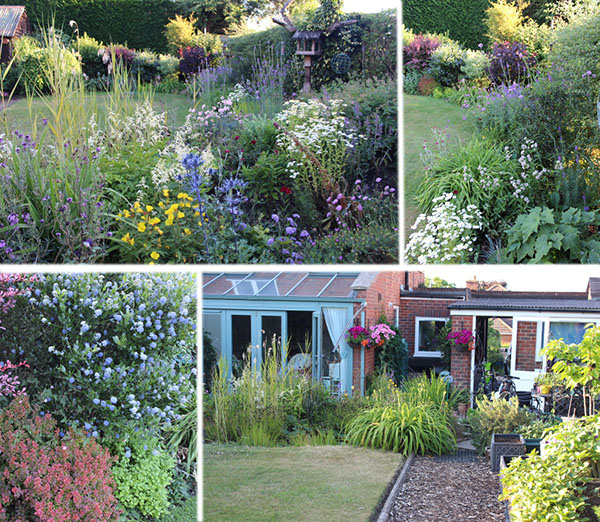Last weekend I was struck down by a severe bout of garden envy, a perplexing condition of conflicting symptoms that leaves the afflicted feeling both deflated and inspired in equal measure.
In fact, I spent two gloriously sunny afternoons ambling around the back gardens of Kinver, a rural village in the West Midlands, with friends who share my enthusiasm for all things green and a healthy dose of Latin plant name dropping.
Lessons learned
For this year’s Kinver Open Gardens event, eight brave households opened up their beds and borders to public scrutiny to raise funds for Compton Care, welcoming friends and strangers alike to stroll across their lawns and steal their ingenious ideas. Here’s what I learned from the gardeners of Kinver.
Garden 1
by Mary and John Tromans
You can cram a wide variety of plants into a small space if you keep chopping it all back.

With Clematis, roses and Euonymous clambering up and over fences and pergolas, an eye-catching Wedding Cake Tree (Cornus Controversa Varegata) on sentry duty in the middle of the lawn, plus strident zebra grass and blooming Brachyglottis, this was a plant lovers’ paradise.
Garden 2
by Rosemary Pope and Peter Roberts
Just because a garden is rectangular it doesn’t have to look rectangular.

Here, the garden had evolved from the blank canvas of a children’s play area to a masterfully designed oasis of trees, shrubs and perennials, complete with maple-shaded fish pond, pot-adorned bird table and tinkling wind chimes. And the secret to slug-proof hostas? Frogs – lots of them!
Garden 3
by Louise and Derek Beddow
A garden can be functional as well as beautiful.

With views across the rooftops from Kinver to Dudley, the owners of this garden had landscaped a 4-metre drop into a terraced space for outdoor living. The edges of gravel paths and decking were softened by ferns and Phlomis, while strategically placed pots overflowing with geraniums and verbena provided colourful accents at every level. Star of the show though was the sky blue summer house, complete with log burner, bar and juke box.
Garden 4
by Rachael and David Baker
A lot of toil and effort reaps its rewards, but a touch of quirky creativity can create something magical.

Set over three levels, the owners describe this garden as ‘a never-ending project’ but it was clearly an accomplished labour of love. The cottage garden planting commanded attention against a back drop of mossy dry stone walls, herringbone brick paths and dozens of fledgling blue tits flitting around the feeders. But it was the artistic flourishes that bedazzled: a bench covered by a willow arch, lanterns in borders and teacups in trees, and toadstools at every turn. I wouldn’t have been surprised to find fairies at the bottom of this garden.
Garden 5
by Jim and Chrissy Monk
You can’t have too much colour!

From the front gate onwards it was obvious that someone here loves to grow plants. Every inch of this compact space was put to work, with vegetables cohabiting with flowers among the beds, pots of petunias, and hanging baskets filled with fuschias and lobelia. Add to this an exuberant mix of connifers, hostas, sedum and gunnera, with copious strings of bunting, and this garden was quite simply a joyful kaleidoscope of texture and colour in every direction.
Garden 6
by Jane and David Bills
Choose plants that will provide interest throughout the year.

Here, a huge expanse of lawn had been cleverly cut into sweeping borders filled with shrubs, perennials, roses and bulbs for year-round interest. Described by the owner as a ‘plantaholic’s paradise’, the borders were full of fascinating specimens. Most were helpfully labelled, but I’m still looking a few up!
Garden 7
by Carol Westwood
Water features are a superb way to create an atmosphere of peace and tranquility.

At the end of a lawn surrounded by mature trees and shrubs, a hidden chapel alluded to the enchanted world beyond, as we followed a shady path past hidden bowers, an ancient cave with candles burning, and statues framed by ferns and ivy. But it was the gentle sound of flowing water from a host of different water features that created an atmosphere of peace and tranquility here, culminating in the River Stour itself.
Garden 8
by Ingrid Caras-Altas
In a large garden, divide up the space to create a journey through different areas with different functions.

This huge garden had been cleverly divided into three parts. At the top, the living space to relax in comprised a small lawn surrounded by borders and a two-level pond. In the middle, the ‘work’ area – a huge allotment of vegetables and herbs interspersed with calendula, lupins and foxgloves, and a cut flower area where cornflowers and sweet peas were bursting with colour and scent. At the bottom, a mown meadow with rose beds and fruit trees, which also acts as a flood plain should the river Stour break its banks.
Reappraisal
Having viewed all eight of these very different gardens, I was buzzing with ideas, and by the time I got home I was ready to re-evaluate my entire garden scheme.

But then I tried to imagine how a visitor would view my garden, and was pleasantly surprised by what I saw.
Thank you Kinver gardeners for the impetus I needed to see my own garden through fresh eyes – and for lots of ideas that I can put into action.
Visit a garden
If you are looking for inspiration, then I highly recommend you visit an English country garden. Go to the National Garden Scheme’s ‘Find a Garden’ page and plug in your postcode. There are plenty of private gardens opening their doors to the public to raise money for nursing charities.
I’d love to hear about the gardens you visit, so please do report back in the Comments section below with your recommendations.
